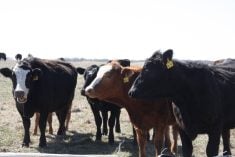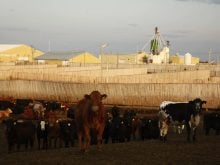This cattle market information is selected from the weekly report from Canfax, a division of the Canadian Cattlemen’s Association. More market information, analysis and statistics are available by becoming a Canfax subscriber by calling 403-275-5110 or at www.canfax.ca.
fed price down
The market tone last week was lower with prices on track to establish a new low for the year.
Dressed bids and sales were reported from $275-$280 per hundredweight delivered. Trade was too light to establish an average live price.
Read Also

Flax sector sees omega-3 opportunity
SASKATOON — A global shortage of omega-3 oils could be an opportunity for the flax sector, says an industry official….
Canadian and U.S. fed prices are moving in opposite directions, which has weakened the Alberta-Nebraska cash-to-cash basis.
March is often the weakest basis month of the year.
Alberta fed cattle traded about $13 lower than the United States, which is the weakest level seen since February 2015.
The U.S. cash trade surged higher as the Canadian market weakened, which might support the Canadian market this week.
Late in the week, prices in the northern U.S. were up US$6 from the previous week at $220 dressed, or C$290.
A handful of Canadian cattle were committed to U.S. plants and sold on a formula price arrangement.
The two major western Canadian packers have both in the same week put in a five-day week only once this year, in January.
Export volumes could pick up because of reduced slaughter rates and weakening basis levels,
A greater percent of cattle are yielding grade 3 due to the heavy carcass weights.
For the week ending March 5, yield 3 as a percent of total yield grades is 33 percent compared to 25 percent last year.
Fifty percent trim prices are struggling, and prices are trading below the three-year average.
cows down
D1, 2 cows ranged $100-$114 per cwt. to average $106.71, down $1.50. D3 cows ranged $85-$104 to average $95.33.
Rail grade prices ranged $207-$212 per cwt. delivered.
Butcher bulls fell $1.50 to average $133.50.
Weekly western Canadian non-fed slaughter to March 5 rose four percent to 8,020 head.
Exports are down 16 percent this year at 44,952.
Volumes at auction are expected to moderate.
Feeders lower
Steers fell more than $4 per cwt., and heifers were down almost $2.50.
Stockers and feeders lighter than 600 pounds saw lacklustre buying interest, and prices were sharply lower.
Those interested in buying cattle to put on grass showed mixed interest on 600-800 lb. feeders, and prices were steady to $3.50 lower.
Feeders heavier than 800 lb. were a little lower.
Weekly auction volume rose nine percent to 37,571. Volume is down three percent to date.
Weekly exports to Feb. 27 surged to 7,389 head, but the yearly total is still behind last year.
Auction volumes should seasonally increase.
Dry pastures in Alberta could defer interest on middle weight grass types, but feedlot interest for bunk replacements has improved.
Bred cows were $1,500-$2,600 per head.
U.S. beef rises
Retailers are buying for the coming barbecue season.
U.S. Choice was up US$5.49 at $225.24, and Select rose $2.21 to $213.85.
Canadian prices were not available.
Feedlot numbers rise
The number of cattle in Alberta and Saskatchewan feedlots as of March 1 rose seven percent to 928,324 head.
February placements rose nine percent to 138,566. Placements of calves and light stockers weighing less than 700 lb. were up 25 percent, while placements heavier than 700 lb. rose three percent.
Marketings in February fell one percent to 117,540, which was the smallest February marketings in the history of the report going back to 2000.














